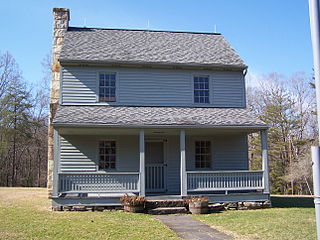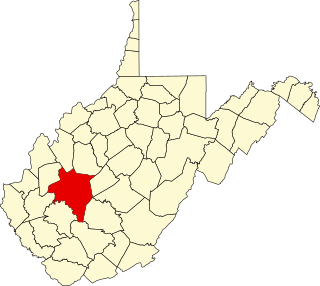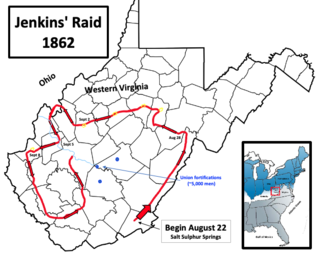
The Battle of Carnifex Ferry took place on September 10, 1861 in Nicholas County, Virginia, as part of the Operations in Western Virginia Campaign during the American Civil War. The battle resulted in a Union strategic victory that contributed to the eventual Confederate withdrawal from western Virginia, which in turn led to the creation of the State of West Virginia two years later.
The 23rd Ohio Infantry Regiment was an infantry regiment in the Union Army during much of the American Civil War. It served in the Eastern Theater in a variety of campaigns and battles, and is remembered with a stone memorial on the Antietam National Battlefield not far from Burnside's Bridge.

The U.S. state of West Virginia was formed out of western Virginia and added to the Union as a direct result of the American Civil War, in which it became the only modern state to have declared its independence from the Confederacy. In the summer of 1861, Union troops, which included a number of newly formed Western Virginia regiments, under General George McClellan drove off Confederate troops under General Robert E. Lee at the Battle of Philippi in Barbour County. This essentially freed Unionists in the northwestern counties of Virginia to form a functioning government of their own as a result of the Wheeling Convention. Before the admission of West Virginia as a state, the government in Wheeling formally claimed jurisdiction over all of Virginia, although from its creation it was firmly committed to the formation of a separate state.

The Battle of Charleston was a Confederate victory in Kanawha County, Virginia, on September 13, 1862, during the American Civil War. Troops led by Major General William W. Loring defeated a Union force led by Colonel Joseph Andrew Jackson Lightburn. This battle, which featured extensive use of artillery but few casualties, was the second major fight in Loring's Kanawha Valley Campaign of 1862 that succeeded in driving Union forces out of the Kanawha River Valley. All points in the Kanawha River Valley were in the southwestern part of Virginia at the time of the battle, but are now part of the state of West Virginia.

The 4th West Virginia Infantry Regiment was an infantry regiment that served in the Union Army during the American Civil War.
The 5th West Virginia Infantry Regiment was an infantry regiment that served in the Union Army during the American Civil War.

The 2nd West Virginia Cavalry Regiment served in the Union Army during the American Civil War. It was organized in Parkersburg, Virginia during September 1861. Most of the original members of this regiment were from southeastern Ohio, and planners thought that this regiment would become the 4th Ohio Cavalry. Their application was rejected by the governor of Ohio, so the unit became the 2nd Regiment of Loyal Virginia Volunteer Cavalry. The "Loyal Virginia" part of the name was replaced with "West Virginia" after the state of West Virginia was officially admitted to the Union in 1863. Today, the National Park Service lists them as 2nd Regiment, West Virginia Cavalry under a heading of Union West Virginia Volunteers.
The 10th Ohio Infantry Regiment was an infantry regiment in the Union Army during the American Civil War. The regiment was also known as the Montgomery Regiment, and the Bloody Tenth. The 10th Ohio Infantry was predominantly recruited from Irish Americans, but had two companies consisting of German Americans.

The 22nd Virginia Infantry Regiment was an infantry regiment from the western Virginia that served in the Confederate States Army during the American Civil War. Its commander was George S. Patton Sr., the grandfather of World War II General George S. Patton.

Joseph Andrew Jackson Lightburn was a West Virginia farmer, soldier and Baptist Minister, most famous for his service as a Union general during the American Civil War.
The 1st Kentucky Infantry Regiment was an infantry regiment that served in the Union Army during the American Civil War.
The 37th Ohio Infantry Regiment was a Union Army regiment, composed of German-Americans, in the American Civil War. It was organized in the fall of 1861, under Colonel Edward Siber, and served in the Kanawha Valley until December 1862. It joined the Union army operating against Vicksburg, Mississippi, in January 1863, and participated in the various engagements of the siege. After the fall of that stronghold it was moved across Tennessee from Memphis to Chattanooga, and took part in operations of the 15th Corps, subsequent to, and at the taking of Atlanta, Georgia. It then followed the fortunes of that well-known corps until the reaching of Washington, D.C. From Louisville, Kentucky, it went with the 2nd Division of the Corps to Little Rock, Arkansas, and was there mustered out in August 1865.

The 36th Virginia Infantry Regiment was an infantry regiment mostly raised in the Kanawha Valley for service in the Confederate States Army during the American Civil War. It fought mostly in western Virginia, Tennessee, and Kentucky.

The 26th Virginia Infantry Battalion was a unit of the Confederate States Army organized on May 20, 1862 from men of the 59th Virginia Infantry Regiment who were not captured at the Battle of Roanoke Island and additional companies of recruits. It was commanded by Lt. Col. George M. Edgar and, after his capture in 1864, by Capt. Edmund S. Read. The battalion was disbanded on April 12, 1865 by Brig. Gen. John Echols at Christiansburg, Va.
The 47th Ohio Infantry Regiment was an infantry regiment in the Union Army during the American Civil War. The regiment had 14 Medal of Honor recipients, the most of any Ohio regiment during the war.

William Henry Powell was an American soldier who fought for the Union in the American Civil War. He was a leader in the iron and nail business before the war, and his leadership abilities proved useful in the military. Powell began as a captain, and quickly ascended to higher roles in the cavalry, including commanding a regiment, a brigade, and then a division. Powell was awarded his country's highest award for bravery during combat, the Medal of Honor, for heroism at Sinking Creek, Virginia, when, as leader of a group of 22 men, he captured an enemy camp and took over 100 prisoners. This was accomplished without the loss of any of his men on November 26, 1862. He was honored with the award on July 22, 1890.

The Kanawha Valley Campaign of 1862 was Confederate Major General William W. Loring's military campaign to drive the Union Army out of the Kanawha River Valley during the American Civil War. The campaign took place from September 6 through September 16, 1862, although an important raid that had impact on the campaign started on August 22. Loring achieved success after several skirmishes and two battles, and Union troops retreated to the Ohio River and the safety of the state of Ohio.

The Battle of Fayetteville occurred in Fayette County, Virginia, on September 10, 1862, during the American Civil War. A Confederate Army, consisting of multiple brigades commanded by Major General William W. Loring, drove away a Union brigade commanded by Colonel Edward Siber. The battle is part of the Kanawha Valley Campaign of 1862.

The 23rd Virginia Infantry Battalion, often called "Derrick's Battalion", was an infantry battalion in the Confederate Army during the American Civil War. It fought mostly in western Virginia and the Shenandoah Valley, and was usually part of a brigade commanded by John Echols or George S. Patton. By 1864, the brigade was usually part of a division commanded by Major General John C. Breckinridge or Brigadier General Gabriel C. Wharton.

Jenkins' Trans-Allegheny Raid was a Confederate cavalry expedition in the American Civil War that took place in Western Virginia and Ohio during August and September 1862. The raid was led by Brigadier General Albert G. Jenkins, and it started on August 22 as a preliminary step in Confederate Major General William W. Loring's military campaign to drive the Union Army out of the Kanawha River Valley. That campaign, known as the Kanawha Valley Campaign of 1862, took place from September 6 through September 16. The purpose of Jenkins' raid was to get behind the Union Army outposts located near the beginning of the Kanawha River, and cut off their main route of retreat to the safety of Ohio.












